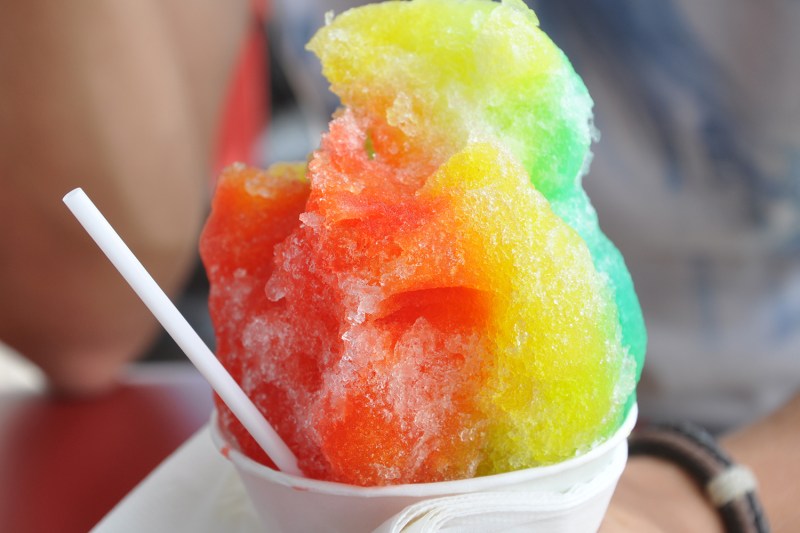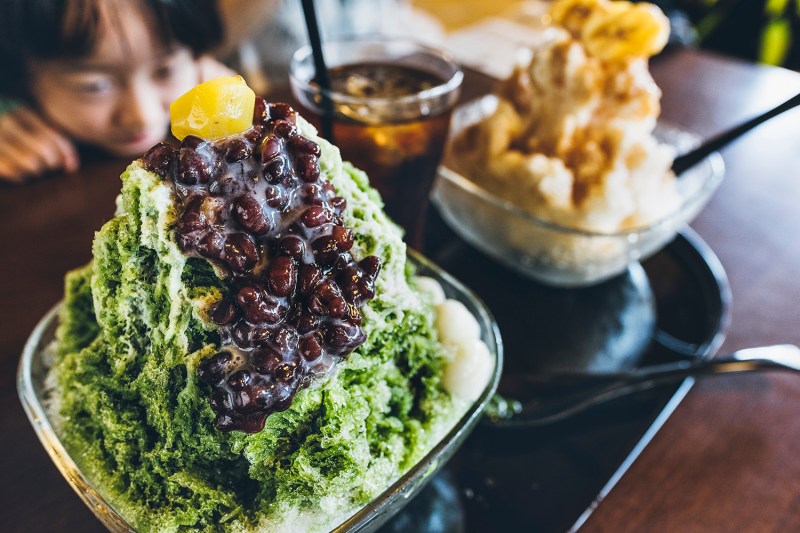Hawaiian shave ice is as refreshing as a dip in the Pacific Ocean on a balmy afternoon. In paradise, it’s as prevalent as a good wave and as eye-catching as a coastal sunset.
Unlike snow cones, where the syrup so often drains to the bottom, there’s balance. Shave ice absorbs the flavor more evenly thanks to its plethora of super-tiny ice bits. The consistency is fine and pillowy, like freshly fallen snow. That’s a decidedly mainland thing to say but probably the most relatable.

It’s served in a simple cup, but the flair comes through via vivid colors offered by the added fruit concentrates. In between surf lessons, snorkel stops, or small-town visits, you’d be hard-pressed to find a more satisfying beverage.
Like bubble tea, shave ice’s origins can be traced to Taiwan. As large groups of Japanese moved to Hawaii to work the plantations, they brought with them early renditions of the drink (called kakigori). It was initially enjoyed by royalty before taking on a more blue-collar quality after traveling across the Pacific. Today, there’s really some form or another of the stuff anywhere where tropical climates demand a thirst-quenching and body-cooling take on an icy beverage.
In Hawaii, it’s about as easy to spot as a food cart pod on the mainland. Stands pepper the sides of major roads, offering yet another excuse to pull off the main road and drink in your heavenly surroundings. Fresh cane juice is another Hawaiian favorite but it’s tough to match the added texture of a good cup of shave ice.
While great on its own, vacationers are wise to inject their shave ice with a little rum or a semi-sweet infused cider from a local outfit like Paradise Ciders. Hawaiians like to add a few other things, too, from mochi balls and fresh fruit to vanilla ice cream. In places like Maui and Oahu’s north shore, it’s common to add a snowcap or a top layer of sweetened condensed milk.
It’s tough to go wrong but some flavors feel more Hawaiian than others. Be on the lookout for pineapple, guava, passion fruit, lychee, mango, even li hing mui. Regulars and high profile folks alike dig the stuff, from Obama to the cast of Hawaii Five-O. And if you can’t select just one flavor, mix a few together. The majority of the flavors play well together.
Shave ice has since become somewhat popular in the lower 48 but, like so many things, it just tastes better in Hawaii. Check out Matsumoto Shave Ice in Oahu, a shop that’s been turning out quality shave ice since 1951. Original Big Island Shave Ice Company in Waimea is another refreshing option, with lively natural flavors like lemon peel and pickled mango as well as intriguing artificial options like tiger’s blood and Blue Hawaii.
JoJo’s of Kauai mixes up some of the best flavor combinations while Ululani’s in Maui features flavors like wedding cake, Calamansi lime, and even its own take on matcha green tea. The latter is set to open a Hollywood, California location by the end of the year, for those of you who can’t make it across the ocean.

Again, there’s nothing like the real thing in its adopted home of Hawaii but it can be made at home. You’ll need a solid food processor, some trial and error, and some quality syrup, of your own making or found online or at your favorite boutique market. You can also get a proper shave ice machine, ranging from entry-level to pretty darn professional.
DIY bartenders are wise to experiment with Tiki-inspired syrups like the tasty concoctions of BJ Reynolds. Mixed mindfully, they can turn your shave ice into a feathery cocktail worthy of some hotel bar in the tropics. Just don’t drink and drive, as tempting as that can be while in vacation mode.
But, to be frank, at-home shave ice will likely pale in comparison to sipping a freshly made batch along the side of a sunbaked Hawaiian road, as you contemplate which beach, waterfall-strewn trail, or National Park you want to explore next.


